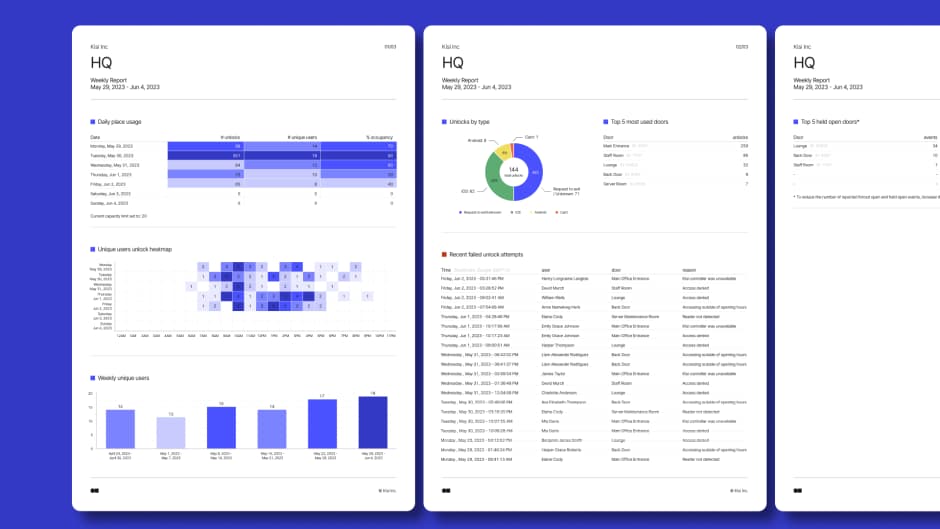Smart workplaces have come a long way over the past several decades—from cubicles and fax machines to cloud storage and digital access credentials. What once would have seemed like something out of a movie is now the reality for many businesses, where employees can unlock doors with a wave of their hand, jump into a leadership meeting from a local coffee shop, and turn on the air conditioning simply by walking into the room.
Many businesses are able to work smarter, not harder, because of technology, saving time and cutting costs in the process. In this article, you’ll learn how to create a connected workplace that runs more smoothly, promotes higher productivity, and lifts employee morale.
What is a smart workplace? #
A smart workplace uses technology to enhance employee comfort, productivity, and performance. It creates a dynamic atmosphere with flexibility and personalization capabilities that support remote, hybrid, and on-site work.

Smart workplace vs. smart office #
To fully understand what a smart workplace looks like, it’s important to distinguish it from two other common terms: smart office and smart workspace. A smart workspace refers to the physical area where work happens, such as a desk, meeting room, or cubicle, while smart office includes all those spaces combined. In this type of office, employees can use certain smart workspace solutions, such as automated lighting or climate control, to enhance their work environment.
A smart workspace is part of a smart workplace, a broader term encompassing not only physical locations but also the entire ecosystem of tools, policies, and infrastructure that allow people to work more efficiently and securely. It serves employees across all locations, including those working from home or in separate office sites.
Because the concept of a smart workplace has a much wider scope, it often involves more comprehensive changes. For example, you can take major steps toward creating a smart office simply by upgrading your heating, ventilating, and air conditioning (HVAC) system and installing occupancy sensors. To achieve a smart workplace, you may need to take things a step further, re-evaluating your tech stack and incorporating tools such as booking systems and access control.

Benefits of a smart workplace #
The specific advantages of a smart workplace depend on your business structure and industry. However, for most organizations, these are the biggest gains:
- Greater productivity and efficiency through automated workflows
- Lower operational costs due to energy savings, better resource utilization, and smarter staffing
- Improved employee experience with more flexibility, environmental control, and accessibility
- Enhanced collaboration, particularly for remote or multi-site teams
- Data-driven decision making based on analytics
- Stronger security and safety through access control
- Optimized space utilization that minimizes waste
Implementing multiple technologies compounds these benefits, particularly if they’re fully integrated.
Core components of a smart workplace #
Smart workplaces consist of a wide range of technologies, policies, and strategies. These are the tools capable of creating the most dramatic changes.
Cloud-based access control #
An access control system like Kisi is one of the pillars of a smart workplace. It allows you to restrict who can enter your building, schedule hours for public access, and secure employee-only spaces. Employees can use credentials, including mobile apps and digital badges, to unlock doors and ensure data, property, and people are protected.
Access control makes building entries more secure and convenient and can prevent issues such as tailgating or buddy punching. It also provides insights into employee behavior and attendance.

Visitor management and check-in kiosks #
A visitor management system is another key piece of technology for a smart workplace. When guests arrive at your building, they can sign in independently using a kiosk or mobile app. Depending on the solution you implement, visitor management systems can also allow for pre-registration, identity verification, and document signing. If you include a badge printer with your visitor management system, guests can also automatically generate badges to wear while on the premises.
Visitor management saves time for front office staff and visitors alike. It streamlines visitor entries so long lines don’t form, and improves security by confirming and displaying visitor identities.
Room and desk booking systems #
Many organizations, especially those with hybrid work models, allow employees to book desks, offices, meeting rooms, parking, and event spaces. A room and resource booking system makes it easy for your team to reserve the items or areas they need, simplifying desk sharing and preventing double bookings.
This type of system also allows organizational leaders to analyze resource use and space utilization, and some solutions include features such as desk grouping and recurring reservations. Along with providing valuable information to management, room, parking, and desk booking software also eliminates some of the frustrations employees face when planning their work days.
IoT integrations #
Internet of Things (IoT) devices and sensors have driven many of the most impactful changes in the modern office environment. For instance, installing occupancy sensors allows you to automate lighting and HVAC controls, adjusting the temperature or light level based on whether people are present at the time.
These automations can significantly reduce your energy consumption, ultimately lowering your utility bills. It also supports higher employee satisfaction and retention. Workers generally feel more comfortable if they can personalize their environment, and studies show increased comfort results in higher productivity levels.

Workplace analytics and space utilization tools #
Understanding space utilization and employee patterns is crucial. With modern technology, you can use a combination of sensors and booking data to analyze how the physical spaces in your office are being used. Information about occupancy, desk and meeting room bookings, employee movement, and peak usage times is especially beneficial.
These insights enable more informed decision making. For example, if you use a tool that detects when workspaces are in use, you can determine which desks in your office are often empty and determine a better use for them.
Hybrid work enablement and automation #
Many popular smart workplace tools support flexibility and hybrid work models. They include communication tools, such as video conferencing and messaging software, virtual whiteboards, and asynchronous video recording. In addition, you can use project management software and automated workflows for routine tasks, such as email, scheduling, and social media posts.
These types of solutions can handle tedious, time-consuming work that would ordinarily consume several hours of an employee’s day. As a result, your team can dedicate more time and energy to tasks requiring creativity, critical thinking, innovation, and problem solving skills. They can also collaborate and get work done while working on hybrid schedules, where people aren’t consistently in the office together.

Connected systems and locations #
All these solutions serve separate purposes in enhancing your office. However, if you want to get the greatest value, look for solutions with integration capabilities. Connected systems, such as Kisi’s One Security Platform, allow for more seamless management and give a fuller picture of your operations.
For example, you can use an access control system in conjunction with room and desk booking. Management can use a single platform to review desk bookings, manage visitors, and approve or revoke employee credentials.
Common challenges for smart workplaces #
Creating a smart workplace is a worthwhile goal that pays off for everyone involved, from organizational leaders to employees to customers. Unfortunately, some businesses miss out on growth opportunities because of concerns about the risks.
Cost concerns #
For many organizations, the biggest obstacle when establishing a smart workplace is financial. Investing in a complete overhaul can strain even a successful business’s budget.
If you’re concerned about cost, think of the transition as a gradual shift rather than an overnight transformation. You don’t have to purchase every smart workplace solution at once. Instead, prioritize which areas of your business will get the most benefit from an upgrade, and commit to additional changes over time as your budget allows.
At the same time, keep in mind that the upfront cost of these changes is often offset by higher productivity, energy savings, and reduced waste. For example, switching to a cloud-based access control system can save you money on 24-hour security staffing, replacement keys, and losses due to break-ins and vandalism.

Lengthy transition times #
Implementing new solutions means dedicating time to setup, configuration, and integration. On top of that, employees will likely require training and will go through an adjustment period before coming fully proficient with your new tools. During this phase, some organizations experience lower productivity, which can temporarily affect profitability.
Working with a reputable partner like Kisi can help you avoid or minimize many of these growing pains. Some providers handle every aspect of your implementation, using expert teams who know how to keep downtime to a minimum. You can also benefit from a user-friendly system that doesn't require complex onboarding or request employee training sessions to get everyone up to speed as quickly as possible and avoid lengthy productivity dips.
How to create a smart workplace #
Making your workplace smarter is a lengthy, sometimes overwhelming process. Here’s how to get started:
- Analyze your organization’s needs: Start by looking at gaps in your organizational performance, employee satisfaction, and building security. Base your analysis on existing data and observations, as well as employee complaints or requests over the past several years.
- Invest in must-have tools and integrations: Once you know your priorities, you can select solutions for your organization. Focus on tools you can integrate with each other and your existing systems, and consider trying a free demo before you commit to a particular provider.
- Provide employee training: Choosing user-friendly, intuitive technologies is a great step to ensuring you can implement them successfully in your organization. All the same, provide employees with in-depth training and troubleshooting steps so they feel comfortable using the new tools available to them.
- Take advantage of workplace analytics: Smart workplace solutions provide extensive data, and many tools have built-in reporting and analytics capabilities. Periodically review this information so you have a deep understanding of what changes might be necessary.
- Collect feedback and make improvements: Along with data analytics, draw conclusions about the effectiveness of your smart workplace setup by communicating directly with employees. Ask them for input on what’s working, what isn’t, and what they need.
As you work through these phases, don’t hesitate to reach out for help. Many companies providing smart workplace solutions, including Kisi, are happy to share tips about integrations, implementation, and system maintenance.

Raise your workplace IQ with Kisi #
In the past, smart workplaces were only achievable for large companies with massive budgets, who often had solutions designed specifically for them. Today, businesses of all sizes can get customizable smart solutions to address their unique challenges.
Kisi offers future-proof solutions for smart workplaces across multiple industries. Whether you’re running a small business, operating a coworking space, or managing a healthcare facility, you can boost your workplace intelligence with our access control, visitor management, and booking tools. Reach out to request a quote, sign up for a free trial, or get a demo.

Vera Eftimovska
Marketing Campaign Manager at Kisi, blends her psychology background with hands-on experience in access control and workplace security. Passionate about how technology and human behavior intersect, she shares insights that help businesses build resilient, future-ready, and security-driven workplaces.



